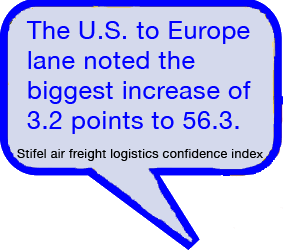| 
What’s this? Could the upward run
on air cargo markets be continuing, and is IATA’s bullish line on
the market going to last more than a solitary quarter? Well, yes and no.
 Certainly,
the latest signals for air freight are most definitely positive and this
is causing some excitement at FlyingTypers after so many fallow
years, although we’re perhaps less enthusiastic than respondents
to Stifel’s latest air freight index. Certainly,
the latest signals for air freight are most definitely positive and this
is causing some excitement at FlyingTypers after so many fallow
years, although we’re perhaps less enthusiastic than respondents
to Stifel’s latest air freight index.
Although the overall October Stifel Logistics
Confidence Index compiled by Transport Intelligence slipped 0.4 points
to 58.9, the air freight logistics confidence index improved 0.8 points
(compared to a month earlier) to reach 56.5.
“Trade lanes were mixed, with declines
noted on the Europe to Asia lane, which fell 0.3 points to 51.3, and the
Europe to Asia lane, where a fall of 0.7 index points to 51.3 was noted,”
said senior Ti analyst Cathy Roberson. “Meanwhile, the U.S. to Europe
lane noted the biggest increase of 3.2 points to 56.3.”
She said the ‘expected situation’
also improved, increasing 1.2 points to 59.6 with the U.S. to Europe lane
again noting the biggest gain, up 3.0 points to 57.7.
“In the short-term it is likely air
freight volumes will remain positive through the end of the year, thanks
in part to new electronic product announcements and the upcoming holiday
season,” she said.
The latest volume figures also appear to
be singing from the Stifel song sheet.
September figures from the Association of
Asia Pacific Airlines revealed an ongoing pick-up in international trade
driven by exports from key Asian manufacturing centers. This saw international
demand increase 5.3 percent year-on-year last month when the freight load
factor climbed 0.8 percentage points to 64.1 percent after a 4 percent
increase in offered capacity.
Over the first three quarters, AAPA carriers
recorded a 5.1 percent increase in air freight demand compared to the
same period in 2013.
Asia’s leading airports are also reporting
major gains. Shanghai Pudong International Airport Cargo Terminal achieved
year-on-year tonnage growth of 20.31 percent in September and volumes
were up 16.55 percent in the first three quarters of 2014. Meanwhile HKIA,
the world’s largest international freight airport, saw volumes climb
5.2 percent in September, and over the first nine months volumes were
6.7 percent higher than a year earlier.
 Leading
forwarders and express operators are also positive on air freight. Panalpina
said its air freight volumes were up 4 percent year-on-year in the first
nine months of 2014, while FedEx said it expected to move more than 290
million shipments between Black Friday and Christmas Eve, an 8.8 percent
increase in overall year-over-year peak seasonal volume. Leading
forwarders and express operators are also positive on air freight. Panalpina
said its air freight volumes were up 4 percent year-on-year in the first
nine months of 2014, while FedEx said it expected to move more than 290
million shipments between Black Friday and Christmas Eve, an 8.8 percent
increase in overall year-over-year peak seasonal volume.
“December 15 is projected to be the
busiest day in company history, with a forecasted 22.6 million shipments
moving around the world,” said the company.
Indeed, long-term forecasts—even from
the notoriously bearish analysts employed by IATA—are now looking
(relatively) positive.
Driven by strong growth in the Middle East
and Africa, in the period 2014-18, IATA expects international freight
volumes to expand at a compound annual growth rate of 4.1 percent. The
fastest growing international routes will be between the Middle East and
Asia, which will expand at 6.2 percent per year.
“An average of more than 4 percent
growth for the next five years would be a marked improvement on the performance
of recent years. Since 2011, for example, growth in freight tonnes has
averaged just 0.63 percent per year,” said Tony Tyler, IATA’s
cautious director general and CEO.
Not one to pass up a chance to talk down
market confidence, however, Tyler also warned of “overall risks
to the economic outlook,” which he believes remain on the downside.
Trade protectionism, geopolitical concerns,
volatility of oil prices, competition from rival modes, and flying pigs
(ok, we added that last one!) were all factors that could turn air freight’s
positives into negatives, according to Tyler, who cautioned that the “air
cargo industry certainly cannot afford to be complacent.”
Hardly likely; thanks, Tony.
Sky King |





